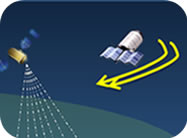
| {column0} |
| {column0} |
 One problem satellite operators face is differential charging of the spacecraft. During high speed solar wind streams, the electron flux increases. When a satellite travels through this energized environment, the charged particles can accumulate in electronic components. Eventually, electrical discharges can arc across spacecraft components, harming and possibly disabling them. The Relativistic Electron Forecast Model (REFM) provides guidance regarding electron fluence levels.
One problem satellite operators face is differential charging of the spacecraft. During high speed solar wind streams, the electron flux increases. When a satellite travels through this energized environment, the charged particles can accumulate in electronic components. Eventually, electrical discharges can arc across spacecraft components, harming and possibly disabling them. The Relativistic Electron Forecast Model (REFM) provides guidance regarding electron fluence levels.
Satellite operators must also be aware of energetic particle (proton) events following large solar flares. The high energy particles can disrupt sensitive electronics within the spacecraft and cause degraded operations or complete loss.
A Satellite Scenario:
A satellite operator, Audrey, received an alert for a 10 MeV greater than 1000 pfu event (S3) from the Space Weather Prediction Center. She had planned to upload some commands to the spacecraft to perform routine maintenance. She calls Ben, the SWPC forecaster, to ask how long the conditions are expected to last. Ben tells her the event is still in progress, the flux levels are still increasing, and he expects the event to last at least another 24-36 hours. Based on this information, Audrey decides to postpone commanding the satellite until the event is over.
Large flares which release energetic particles are frequently accompanied by strong radio bursts at many frequencies. These radio bursts can interfere with the satellite communication when they occur on the same frequencies that the satellite uses. Also the satellite signals are affected by the sudden variations in the density of the ionosphere created by the x-ray flare.
Finally, Geomagnetic storms and increased solar ultraviolet emission heat the Earth’s upper atmosphere, causing it to expand. As a result, the density at the orbit of satellites up to about 1000 km increases significantly. This results in increased drag on satellites, causing them to slow and change orbit slightly. Unless low-Earth-orbit satellites are routinely boosted to higher orbits, they slowly fall, and eventually burn up in the Earth’s atmosphere.
 Skylab is an example of a spacecraft that re-entered the Earth's atmosphere prematurely (in 1979) as a result of higher-than-expected solar activity. This high solar activity caused Earth’s atmosphere to expand. The increased friction enhanced the rate of orbital decay, and Skylab fell to Earth.
Skylab is an example of a spacecraft that re-entered the Earth's atmosphere prematurely (in 1979) as a result of higher-than-expected solar activity. This high solar activity caused Earth’s atmosphere to expand. The increased friction enhanced the rate of orbital decay, and Skylab fell to Earth.